Final report for LS19-317
Project Information
Cow-calf and stocker cattle operations often face a shortage of grazable forage on pastures during summer, early fall and winter. To provide access to high quality, grazable, and sustainable forage, we plan to study the feasibility of an integrated system using sub-surface poultry litter application on pasture in tandem with planting a mix of summer annuals and legumes to increase both the efficiency and level of nutrient application. This will enhance both forage quality and quantity for grazing. In addition to spring-planted annuals we wish to investigate the potential for fall planting winter annuals for winter and early spring grazing. Those plantings will also benefit from the spring litter application given the slow release nature of nutrients with litter. In comparison to conventional perennial pasture forage species, our least-intensive system, these annuals are expected to increase nutrient uptake from the soil and thereby extend the grazing season, while keeping nutrients below the soil surface. With litter applied sub-surface, we can expect to avoid nutrient runoff, an increase water infiltration and soil water-holding capacity given greater root growth, and an eventual increase in soil organic matter.
Experiments will be conducted at research centers and four cooperating farms where crops are selected based on landscape suitability. Variation in crop mix options and animal type will allow comparison of profitability and income risk. To assist with this task, a cattle decision support system exists that can: 1. model forage growth and cattle herd nutrition needs on a monthly basis; 2. calculate greenhouse gas emissions of varying production practices; and 3. perform what-if analyses concerning key economic and environmental performance indicators. However, it is currently not equipped to analyze detailed fertilizer application and annual sod seeding practices.
Therefore, we will evaluate innovative agro-grasslands management approaches by: 1. examining profitability and risks of added forage production using organic litter to extend the grazing season which is expected to lower hay feeding and attendant fuel use; 2. determining the feasibility of using innovative equipment to incorporate both litter and planting crops in a single equipment pass to allow greater use of nutrient rich manures on pastures; 3. matching crop needs to spatially variable landscape attributes to sustainably manage yield potential, soil moisture, and net GHG emissions while increasing beef output that can be marketed as grass-fed and/organic; 4. comparing forage soybean and cowpea sown in conjunction with brown mid-rib sorghum-sudan grass and a ryegrass/cereal rye/wheat and legume mix as winter annuals for livestock grazing (cows, stocker cattle and sheep); and 5. calibrating and modifying the existing cattle DSS tool with producer input to enhance user-friendliness.
Adoption of more annuals and custom, sub-surface applied litter could impact many producers of all operation sizes throughout agro-grasslands in the Southern humid region of the U.S. where approximately one third of all agricultural land is dedicated to pasture and hay. Outreach activities will share successes, pitfalls, and bottlenecks observed across varying degrees of pasture use intensity proposed in this holistic research system.
- To determine the impact of summer annuals on grazing days and animal weight gain in bermudagrass-dominated systems.
- Assess forage production potential of different summer annuals under sod-seeded conditions without grazing.
- Measure changes in soil health across holistic pasture management systems varying in grazing intensity and soil fertility amendment practices under both research and farm conditions.
- Conduct producer field trials to assess field performance of sub-surface poultry litter application equipment that could be modified to plant at the same time.
- Calibrate and modify existing decision support software to provide greater planning support for cattle operations using producer feedback about needed modifications to improve user-friendliness.
Research
In 2020 forage and pasture trials met with significant weather issues as well as changes in site location as discussed below in the research and results discussion. We are excited to report that cattle facilities were refurbished (in fall of 2020) after the tornado had rendered the facilities inoperable for 2020. Unfortunately that meant no cattle trials for 2020. Producer fields near Farmington, AR were treated with sub-surface applied litter as per attached media Spring Litter Subsurface near Farmington and planted to BMR sorghum sudangrass (SS), cowpeas (CP), and forage soybean (FS) on May 6, 2020. With unanticipated strong competition from cool season grasses followed by a 2 month period of warmer than usual weather without rainfall, pasture efforts at both fields on that site did not lead to observations of grazing success as the summer annuals did not establish as expected. Similarly, planting and sub-surface litter application occurred at the West Fork location on May 8, 2020. With early competition from cool season grasses followed by lesser than expected precipitation, the field was left to rest until August after an initial grazing of cool season grasses lessened competition for SS to emerge and thrive. At the West Fork location 3 fall grazings of SS were considered a success for extending fall season grazing with summer annuals. The Alma, AR location had unfavorable weather conditions leading to planting delays and poultry litter that was delivered to the field's side, even though placed on a tarp and covered with a tarp to avoid introduction of moisture from the soil and from rainfall, turned out to be too moist for use in the sub-surface litter applicator. As such, SS was planted by the producer in conjunction with commercial fertilizer so the producer could graze the field. The Alma, AR location had a successful grazing season throughout the summer with cattle gaining at 3-4 lbs per day and was accompanied with a daily ration of 1-2 lbs of corn per head per day.
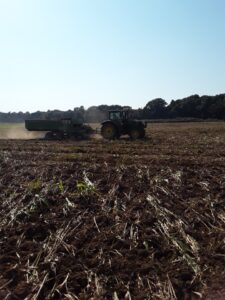
Part of the Alma location was then treated with sub-surface poultry litter after SS residue was disked and winter wheat seed had been broadcasted on Oct. 8, 2020.
Producer fields were soil sampled in February (5, 6 and 21) of 2020 but with COVID, results of these analyses were not available prior to litter application. We applied litter at ~3.5 tons/acre to ensure sufficient nutrient availability on fields for both 2020 and 2021 given 2-yr N-P-K availability from litter applications and expensive transport of sub-surface litter application equipment. Forage trials were planted at the USDA ARS Booneville site not until mid-June given wet weather conditions. Sod-seeded plantings into bermudagrass failed as a result of too much competition and hence forage trials for 2020 were abandoned. Soil sampling was again conducted in early March (5, 6) of 2021. At the time of sampling, the field at Alma showed a much better winter wheat stand where poultry litter had been applied below the surface in the fall in comparison to regions of the field where no sub-surface poultry litter applied (those regions without litter received commercial fertilizer). Soils were again sampled on March (2, 4) in 2022. Results of soil samples of producer fields were shared with producers but are not reported here. A summary of those findings will be available in a video to be released for extension purposes related to this project later in 2023.
For the 2021 production season at the USDA ARS Booneville site both pasture and forage trials were conducted successfully. The grazing study evaluated three different options for summer forages, a warm season perennial pasture typical of most Arkansas pastures (bermudagrass, crabgrass, broomsedge, and some warm season annuals such as foxtails) , sorghum-sudangrass only, and a sorghum-sudangrass plus cowpea mixture (“mixtures” were created with alternating drill passes of sorghum-sudangrass and cowpeas) (Figure 2).
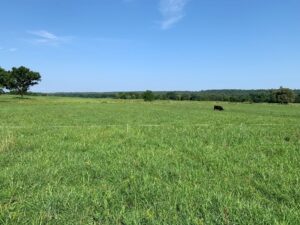
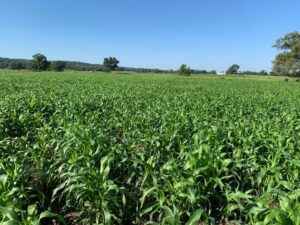
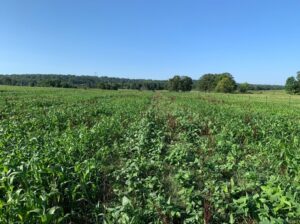
The cool, wet spring in 2021 resulted in a late start to grazing the warm season perennial pasture (June 10) and a late planting for the warm season annuals (June 16-17). Grazing started on annual species on July 15. Eight stocker steers weighing an average of 680 lb at the beginning of the study, were assigned to each 4.5-acre pasture. Cattle were rotated approximately every 10 days on 4 paddocks resulting in a 30-d rest period. The experiment was repeated in 2022. Given better early season weather conditions, timely planting of summer annuals resulted in cattle placement dates that were the same between perennial warm season pasture and the those pastures sod seeded with summer annuals. Results for both years are presented in the Results and Discussion section of this report, below.
Farmer participants were updated of progress to date in on Feb. 10, 2020 at a in-person meeting at the USDA ARS Dale Bumpers Small Farms Research Center. Fields for on-farm research were identified and soil-sampled subsequent to that meeting and sources of poultry litter for application were identified.
Forage trials were conducted as planned for 2019. However, planting was delayed given frequent substantial rainfall events during the planting season such that poultry litter application would have lead to extensive field rutting. Planting was delayed to May 28, 2019 in Booneville, AR and was not completed until June 21 at Fayetteville, AR. At the Booneville location, we experienced difficulties with establishing cowpea (CP) and forage soybean (FS) given herbicide residual from prior year's applications. At Fayetteville, residual herbicide action affected Sorghum sudangrass (SS) and significant competition from bermudagrass lead to abandonment of trials at Fayetteville. At Booneville we did get stands of sorghum sudangrass but had only limited success with the legumes. Forage data was therefore not collected at either site given delayed planting and unanticipated residual herbicide damage. However, cows were allowed to graze out nearly mature stands of SS and completely removed the forage in 2 d indicating that forage produced is palatable and preferred to bermudagrass. To suppress weeds, repeated glyphosate applications were made at Booneville on April 12 and May 20. The second application suppressed weeds and also set back bermudagrass. Given the lack of aggressive forage growth of CP and FS with the residual from prior year's Grazon, the suppression of bermudagrass led to significant weed growth in the absence of CP and FS. Hence, a practice of repeated glyphosate applications will not be practiced in the future. Further, from observations in 2019, given differences in plant height, some shading effects for alternate row planting of SS with CP and/or FS may be an issue that will be observable for plantings to be conducted in 2020.
Pasture trials intended for 2019 met with significant problems. Administrative actions, unknown to the investigators at the time of proposal submission, led to a severance of research ties with the University of Arkansas Monticello research station where pasture trials were to be conducted. Our backup plan was the Savoy research station facilities near the University of Arkansas at Fayetteville. Those plans failed upon realization that poultry litter use was not acceptable at Savoy given that research station's long term focus on solely using swine manure. As a result, pasture trials were canceled for 2019. SARE administration was notified using verbal communication. Inevitable delays for pasture trials will be addressed by applying for a no-cost extension of one year's duration to allow for conducting pasture research trials at the Booneville facilities that were refurbished for this purpose this past year. Cattle were secured for 2020 pasture trials, with pasture paddocks newly fenced, new shade structures and a complete overhaul of handling facilities, alley ways and road access and watering sites. A tornado in 2020 impacted the pasture trials as described above.
Given the relocation of pasture trials to Booneville, and the failure of forage trials in 2019 given unfavorable weather conditions as well as herbicide residual difficulties (2019 Forage and Pasture Update), the research team decided to conduct pasture trials and forage trials at Booneville for 2020-2022 and dropping the Fayetteville forage trial site to conduct more extensive and frequent sampling at the Booneville site that will now coincide with the pasture trials given change in site from Monticello or Savoy. As discussed above forage trials in 2020 were a failure with delayed planting and excessive competition from bermudagrass. Forage trials for 2021 and 2022 will now match the pasture trials in location and years.
On-farm research with collaborating farmer producers was not impacted by changes in experimental research as on-farm trials were originally targeted to commence by 2020. On-farm trials met with both successes and failures as described above. Work for 2021 farm trials involved on planting of annuals as sub-surface litter application was to provide fertility for two years. Producer interest was strong despite setbacks suffered in 2020 due to weather conditions.
Finally, modifications to the decision support software (DSS) tool were pursued. FORCAP is a uniquely comprehensive spreadsheet-based DSS that has been available since 2012 on-line at https://agribusiness.uark.edu/decision-support-software.php#forcap. As currently available, the tool allows users to analyze the impact of changing fertilizer amounts and forage species composition on hay and pasture ground, given a host of cow-calf management practices. However, individual pasture paddock or hay field management practices are not possible. Only overall farm changes are possible. As such, modifications to FORCAP were initiated to guide the user through step-by-step decisions to allow for user specification of grazing access, forage species selection, planting, fertilizer, etc. management decisions on individual pastures and hay fields while reducing some of the options related to livestock management currently available. The approach was presented to producers at our February meeting and met with approval. We expect to have a prototype of this revamped tool ready for producer feedback in the coming year. By late summer of 2020 efforts to continue to modify FORCAP were placed on hold as modifications to the tool were too significant and forage as well as cattle performance information to date were not available. In it's place we began work on a spreadsheet-based decision aid to compare sub-surface litter application to commercial fertilizer and/or broadcast litter. That tool, called the Litter-Soil-Crop Calculator or LSC for short, and an accompanying research publication (with user instructions) in the Journal of Applied Farm Economics can be accessed at https://agribusiness.uark.edu/decision-support-software.php#LSC. This site will also serve to house a videos of producer opinions regarding sub-surface litter applications as well as anticipated research publications related to forage and pasture trial outcomes.
Pasture Trial Summary
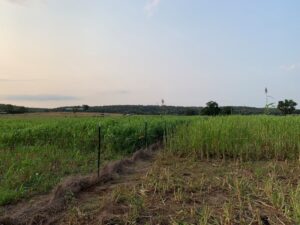
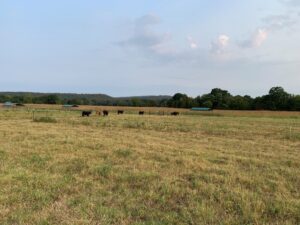
Grazing started on annual species on July 15, 2021 whereas grazing commenced on June 10, 2021 on bermudagrass pastures. Eight stocker steers weighing an average of 680 lb at the beginning of the study, were assigned to each 5-acre pasture (see details in Table 1). Cattle were rotated approximately every 10 days on 4 paddocks resulting in a 30-d rest period. Grazing ended early on all treatments because of drought in early fall. Grazing on perennial warm season pastures and summer annuals pastures ended on September 9 (Figure 4). Therefore, the grazing sessions for each treatment averaged 91 days for the perennial warm season and 56 days for summer annuals. Averaged over the entire grazing season, ADG was 1.7 lb/d in the perennial warm season treatment, 2.6lb/d in the sorghum-sudangrass treatment, and 2.5 lb/d in the sorghum-sudangrass plus cowpea treatment. Animal gain was 128, 144, and 137 lb/hd for the perennial warm season pasture, sorghum-sudangrass only, and sorghum-sudangrass plus cowpea treatments, respectively. Late planting, due to excessive rainfall in May (Figures 5 & 6), resulted in short grazing seasons for the annual systems. Though ADG was superior in the annual systems, the greater grazing days in the perennial warm season pasture resulted in greater profit per head in 2021. In 2022, cattle in-weights were more even across forage species as grazing commenced June 2 across all forage species and was not terminated until September 29th. The summer perennial pasture required mid-season rest periods of 19 and 34 days leaving fewer days on feed as reflected in the weight gains per head (Table 1).
Table 1. Cattle performance measures by year, forage species (bermudagrass (BG), sorghum-sudangrass (SS) and mixture of sorghum-sudangrass and cowpeas (SS+CP) at USDA-ARS Dale Bumpers Small Farms Research Center in Booneville, AR in 2021-22 using commercial fertilizer.
| Year | Forage | In-Weight in lb/hd | Out-Weight in lb/hd | Gain in lb/hd | Average Daily Gain in lb/hd | Days on Feed |
| 2021 | BG | 631 | 788 | 128 | 1.66 | 77 |
| SS | 693 | 838 | 144 | 2.57 | 56 | |
| SS+CP | 690 | 827 | 137 | 2.45 | 56 | |
| 2022 | BG | 571 | 763 | 192 | 1.80 | 95 |
| SS | 612 | 827 | 215 | 1.80 | 119 | |
| SS+CP | 618 | 817 | 199 | 1.67 | 119 |
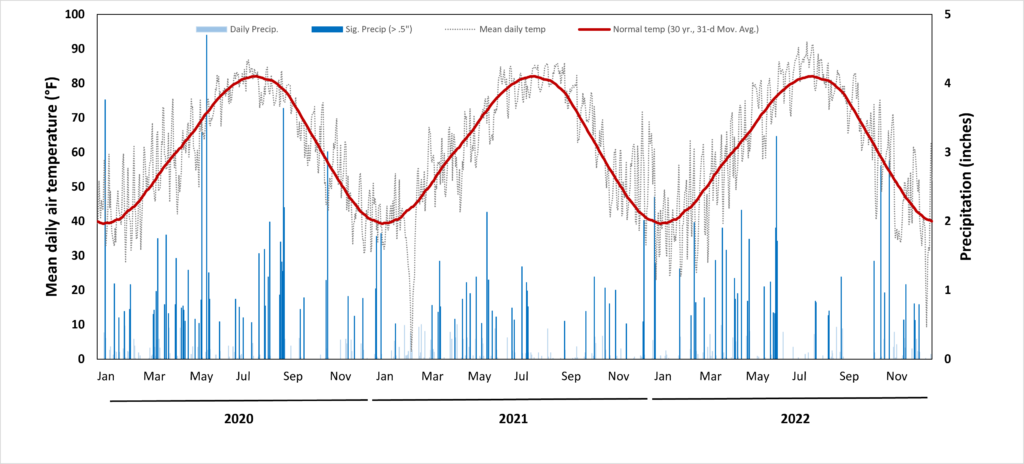
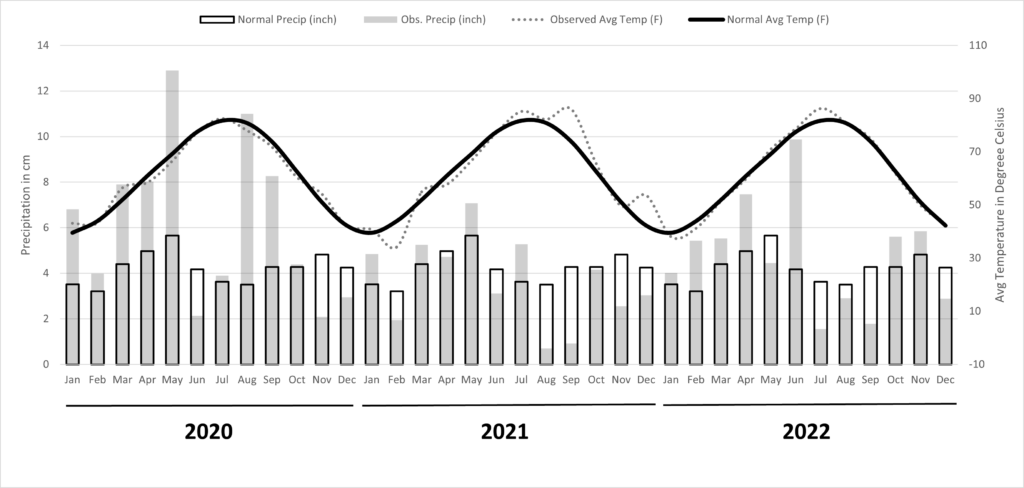
Given these weather conditions, animal performance in economic terms was estimated per head per year using three 5 acre pasture replicates per forage species and 8 hd per pasture leading to 24 observations per forage system per year as there were no death losses. Animals were placed on other comparable nearby perennial warm season grass pastures when treatment pastures did not have sufficient forage. Since all forage systems used the same production practices we accounted only for weight gain and valued said gains using 10-yr, monthly average Arkansas cattle prices with a price slide guided by cattle weight at time of placement and at time of removal from pasture (full weights). The price slide linearly interpolated cattle prices from the #4-500 weight category to the #7-800 weight category for medium frame No. 1 steers. For example, the 10-yr avg. (2013-2022) price for 450# steers in July adjusted for inflation to 2020 dollars was $157.88/cwt. For that same month, the avg. price for a 750# steer was $131.23/cwt. Thus a 635# steer, that was placed on pasture in July was assessed an estimated cost of $141.45/cwt. It's September output price at a higher weight was calculated in the same manner. The difference between the cost of animal at placement and the value of the animal once it left the pasture thus represented the value gain from pasture that would come at different cost across production systems. Bermuda grass was assessed zero cost as perennial warm season pasture were a constant across all forage systems and thus would not help with differentiating among systems. Sorghum-sudangrass was planted at a rate of 20 lb/ac of seed at a cost of $1/lb of seed. Cow-peas were planted at a rate 50 lb/acre at a cost of $0.98/lb including inoculant. As such, sorghum-sudangrass only pastures incurred a cost of $20/acre for seed with an added $12/acre charge for planting using a 12' no-till drill accounting for fuel, repairs, and labor only. Given bermudagrass competition during establishment, summer annuals plots were also treated with 1 pt/acre glyphosate using an ATV sprayer for application at a combined cost of $8.35/ac. Given the stocking rate of ~ 1.6 hd/ac, the added cost for seed, planting, and weed control amounted to approximately $25/hd for sorghum-sudangrass pastures. For pastures employing both sorghum-sudangrass and cowpeas, each crop was planted separately in 12' strips to avoid competition between sorghum-sudangrass and cowpeas and to better observe regrowth (Figure 7). Given the higher seeding rate for cowpeas, cost per head on pastures with a mixture of summer annuals was thus in excess of $34/hd.
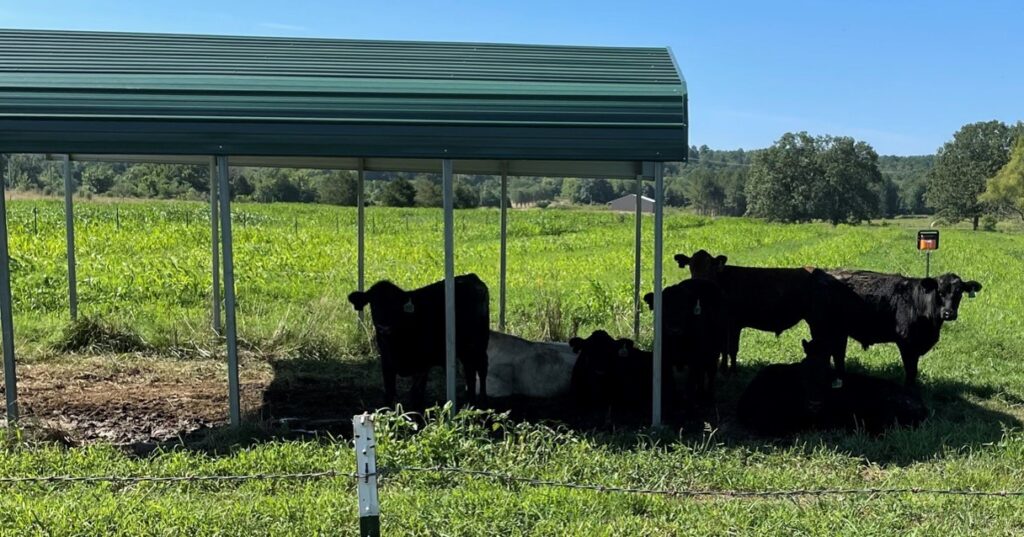
Subtracting these summer annuals pasture management charges from value gain resulted in partial returns per head that could be used to judge relative profitability across the three different pasture management systems: 1) warm season perennial pasture (predominantly bermudagrass (BG)); 2) warm season perennial pasture sod-seeded to sorghum-sudangrass (SS); and, 3) warm season perennial pasture sod-seeded to sorghum-sudangrass & cowpeas (SS+CP). Since a 3-week establishment period for summer annuals is typical and is expected to occur prior to stocking pastures when warm season perennial pastures are not yet grazable (given lack of forage production), BG and summer annuals system grazing would ideally start simultaneously. This was successfully managed in 2022 when May planting of summer annuals allowed a grazing start date common to all systems on June 2. However, in 2021, planting of summer annuals was delayed to mid-June forcing a 5-week delay for commencing grazing with the summer annuals. Since 2 of those 5-weeks could result in grazing warm season perennials prior to plant establishment we adjusted the grazing season for BG pasture to grab only an additional 3 weeks of weight gain rather than the full 5 weeks in 2021. By the same token, value gain for 19-34 days (24 days on average across pasture replicates) of alternate pasture grazing on BG pastures (given mid-season lack of forage in 2022) was subtracted for BG system steers when SS and SS+CP system steers had forage available for the full 119 days of grazing in 2022.
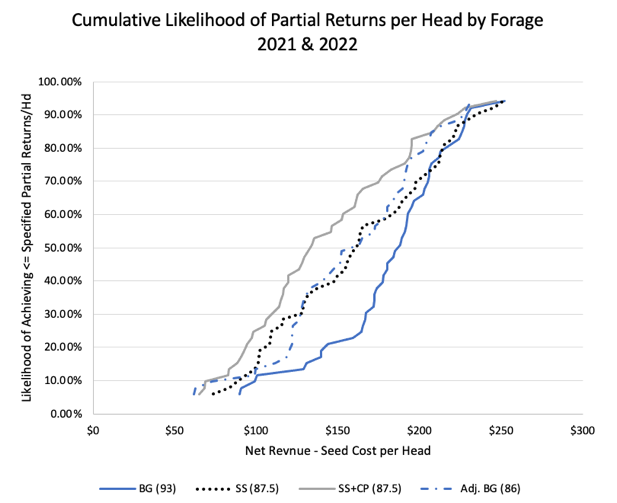
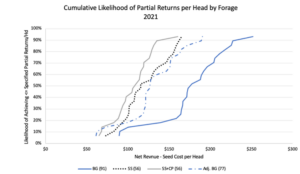
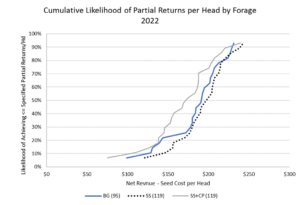
In the graphs above (Figures 8-10) producers prefer steeper lines to flatter lines as flatter lines showcase a larger range of partial returns or relative profitability estimates than steeper lines. Also, producers prefer lines that are furthest to the right, or higher relative profitability. The gray lines had the mixed summer annuals with poorest performance given lesser regrowth potential of cowpeas once grazed and added cost for seed. The sorghum-sudangrass pastures performed poorly in comparison to the BG pastures in 2021 given delayed planted (even once BG pastures were adjusted for a shorter grazing season (days on feed in parentheses next to pasture system names in the legend). On average, BG pasture outperformed SS pastures by approximately $10/hd in 2021 although not statistically significantly so. In 2022, SS pastures outperformed the BG pastures by nearly $30/hd on average, again not statistically significantly so. Across both years, SS pastures performed on average, nearly $3/hd better than BG pastures. At the same time, the SS pastures had a higher bottom profitability estimate across both years and a higher top end performance than BG and as such would be considered less risky. Hence findings are considered numerically important (especially in 2022) but are not statistically significant.
Forage Trial Summary
The small-plot forage trials evaluated production of monocultures of sorghum-sudangrass and cowpeas, and a mixture of sorghum-sudangrass and cowpeas planted in the same row, with poultry litter applied via broadcast, injected below the soil surface, or no litter application. Subsurface application was completed with a mechanized applicator that forms a trench and deposits litter in the trench, the trench is then covered with soil. The bands are 2" wide and 3" deep, configured with 15" band spacings. In subsurface plots, the drill was set to plant between the litter bands to prevent any burn from the litter that could hinder germination or seedling growth (Figure 11). Broadcast applied litter was applied by hand. The litter rate was 3 ton/ac. All species were planted in 15" rows, seeding rates were 20 lb/ac for sorghum-sudangrass alone, 50 lb/ac for cowpeas alone, and for the sorghum-sudangrass and cow pea mixture, seeding rates for both were 20 lb/ac mixed in the same box. Plots were planted and fertilized on June 24, the first harvest occurred on August 4, and the second harvest on September 22.
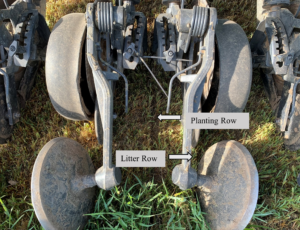
The averages of first year of results show that subsurface application produced the highest yields for all species and mixtures, followed by surface applied litter (Table 2). Across all treatments, sorghum-sudangrass monocultures had the highest yields of 2686 lb/ac, compared to sorghum-sudangrass and cowpeas mixtures at 1990 lb/ac, and lastly cowpea plots averaged 374 lb/ac. All yields, including the sorghum-sudangrass monocultures were low. This is because of the late planting date of June 24 and drought that occurred in late August through September (Figures 5 & 6) as well as including the no fertilizer control in the average. This project was repeated the following year, with no additional litter applied, given biennial fertilizer soil amendment. In this way, we could evaluate if injected litter resulted in greater yields in the second year compared to surface applied litter and a zero fertility control. With an earlier planting date, yields were much larger in 2022 than 2021.
Table 2. Yields for sorghum-sudangrass (SS), cowpeas (CP), and mixtures of sorghum-sudangrass and cowpeas (SS+CP) at USDA-ARS Dale Bumpers Small Farms Research Center in Booneville, AR in 2021-22 across all application methods.
| Year | 2021 | 2022 | ||
| Planting Date | 6/24 | 5/24 | ||
| Cutting Date | 8/5 | 9/22 | 7/12 | 9/14 |
| Forage Species | --- dry matter lbs/acre --- | |||
| SS* | 2,300 | 386 | 2,472 | 2,095 |
| SS | 1,518 | 415 | 2,302 | 2,068 |
| + CP | 58 | none | 122 | none |
| SS+CP | 1,575 | 415 | 2,423 | 2,068 |
| CP | 374 | none | 706 | none |
Yields harvested, regardless of whether no fertilizer was applied, litter was broadcasted or subsurface-applied, show that cowpeas do not regrow for a second cutting and that the mixture of sorghum-sudangrass and cowpeas is not synergistic in terms of yield as sorghum-sudangrass shades out cowpeas as evidenced in Figure 12.
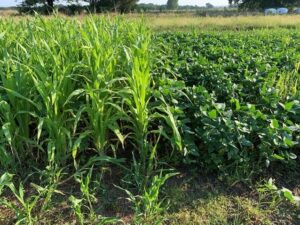
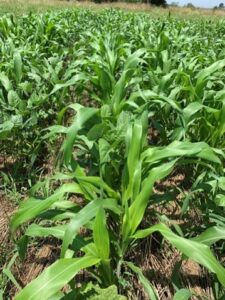
Assuming a producer were to harvest this material as haylage due to extended drying times with sorghum-sudangrass and the likelihood of leaf shatter with cow peas, we assign a $15/acre custom mowing charge, $20/ton for baling and wrapping and $25/ton for 3 ton of litter applied in 2021 only. Further we assign a charge of $6/ton for broadcasting litter and a $40/acre charge for sub-surface application of litter based on our work related to the Litter-Soil Crop Calculator. Spreading these costs over 2 years with a single application of litter in 2021, application cost is roughly twice as high with sub-surface application than with broadcasting. At a seeding rate of 20 lb/acre, seed cost of sorghum-sudangrass only amounts to $20/acre using 15" row-spacing. Cowpeas with inoculant were assessed a cost of $0.98/lb and planted using similar row spacing but at a rate of 50 lb/acre. As such, cowpeas were roughly twice as expensive to seed. The 50/50 mix of the two forage species lies in the middle in terms of cost. Cost for planting and weed control as well as charges for labor, management, and land were ignored as they would be the same across forage species and therefore would not affect relative profitability across production systems. Finally, the quality of the forage grown was assigned different values based on crude protein (CP) content. Using a base price of $150/ton for sorghum-sudangrass haylage, we assessed a quality premium of 0.5% per 1% CP difference from the average of all sorghum-sudangrass samples. The overall average CP content of sorghum-sudangrass samples harvested was 9.74% and compared to 12.66% for cowpeas. This led to price premia and discounts on the basis of CP content ranging from $146.96/ton for 5.7% CP to $154.47/ton for 15.7% CP for individual samples from the forage trials as delineated in Table 2.
Using this information, we calculated relative profitability among forage species and litter application methods by calculating sales per acre of forage produced (adj. for CP content) less costs for seed, litter, and litter application charges and harvest cost only. Hence these returns above specified cost/acre are not profitability estimates for growing these sod-seeded forages on bermudagrass but provide information about profitability differences across these production methods.
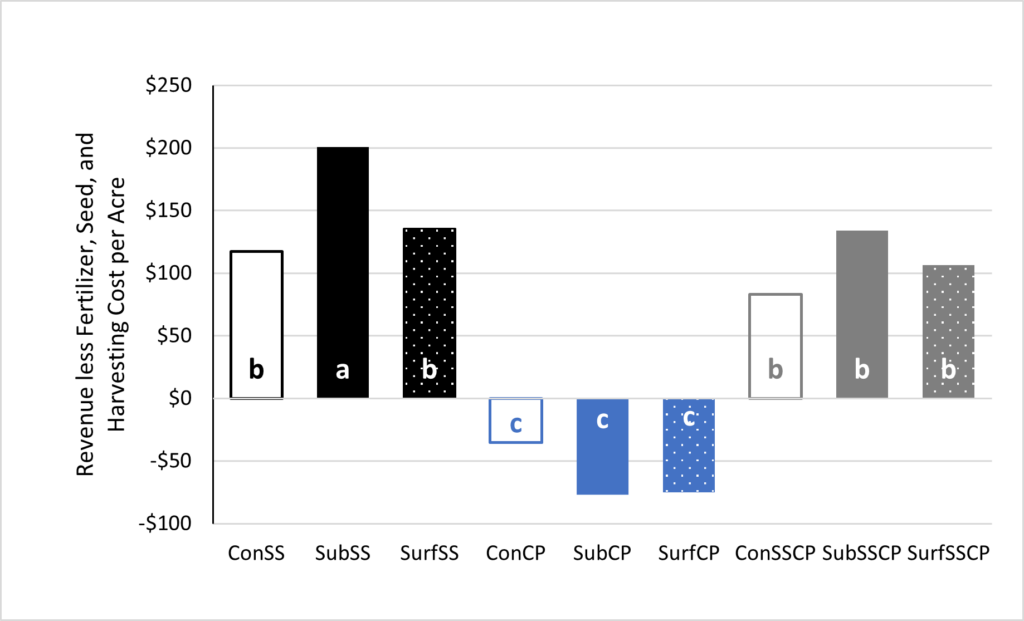
Statistical comparison of these relative profitability estimates revealed significant differences for the interaction of forages species and litter application method as well as a year x forage species interaction at P <0.05. As shown in Figure 13, sorghum-sudangrass with sub-surface application of litter (SubSS) was most profitable and followed by sorghum-sudangrass using broadcasted litter (SurfSS) over the two-year period with a statistically significant yield response to litter application compared to the control (ConSS). Low yields (with no second harvest) and high seed cost explain the cowpea (CP) results whereas the lack of yield synergy (Table 2) and added seed cost of the mixture (SSCP) demonstrate that, despite better forage quality in the mixture, mono-culture planting of sorghum-sudangrass was less costly and higher yielding. A result that mirrors those found in the cattle trial results reported above.
Importantly these results support the practice of sub-surface application of poultry litter despite high cost of application as surface application of litter led to lesser yields given less efficient nutrient use in comparison to sub-surfaced litter.
Educational & Outreach Activities
Participation Summary:
We did have a farmer collaborator meeting to present activities to date and coordinate on-farm trials slated for 2020 and 2021. During that meeting we decided to curtail poultry litter application to a single application in the first year to serve nutrient needs for both years. This will allow cost savings and is possible given the slow release nature of poultry litter nutrients and greater flexibility for summer annuals plantings. Specific fields on collaborator farms were identified and soil sampled to assist with planting and ruminant stocking rate recommendations for 2020.
In March of 2022 we video taped producer collaborators to share their experiences. We plan to work on these videos to develop materials for extending findings once the summer research trials in Booneville are complete near the end of 2022. Outreach material summarizing research trial information and producer experiences will be posted to https://agribusiness.uark.edu/decision-support-software.php#LSC once peer-reviewed publications are available by late 2023. Results to date have been presented at the Southern Agricultural Economics Association Annual Meetings in 2021 and 2023.
Learning Outcomes
Farmers attended a field day at the Booneville research station in August of 2022. We also had a field day presentation near Elkins, AR, in the April of 2023. More outreach impact is expected once video materials or research trials and producer experiences are posted later in 2023.
Key areas of knowledge and attitude were that monoculture additions of sorghum-sudangrass led to better performance than mixtures of summer annuals. Both forage soybean and cowpeas have difficulties competing with bermudagrass and/or are impacted by shading from sorghum-sudangrass.
Second, while cattle trials had no statistically significant results, they did showcase that if planting and establishment of summer annuals in spring is not delayed and good stands are attained that they can improve forage availability in drought years. Adoption on part of a farm's pasture acreage is recommended and in conjunction with sub-surface application of litter if the technology is available.
Four graduate students participated in this research along with one undergraduate honors thesis student. They appreciated the opportunity to work on this project.
Project Outcomes
The project has demonstrated that sub-surface application of litter leads to more efficient utilization of nutrients in the litter in comparison to broadcasted litter as demonstrated in comparisons of yields of sorghum-sudangrass, cowpeas and their mixture. Monocrop establishment of sorghum-sudangrass proved relatively most profitable given lack of synergy between sorghum-sudangrass and cowpeas. Cowpeas in forage harvest systems had poor results given lack of regrowth for a second cutting as well.
Producers were impressed with sub-surface application of litter except for concerns over application speed of the equipment (3 ac/hr). The lack of odor and dust problems with sub-surface application was considered a major improvement compared to broadcasting, as was more efficient utilization of nutrients in the litter.
Pasture trials showcased similar results in the sense that bermudagrass pastures sod-seeded to sorghum-sudangrass only performed better than bermudagrass pastures without summer annuals or those sod-seeded to cowpeas or a mixture of sorghum-sudangrass & cowpeas. Weather conditions proved challenging for both 2021 and 2022 with planting delayed in 2021 and both years with significant summer drought. While economic animal performance results did not show statistically significant differences across study years, insights from individual years supports planting in early May to allow for good stand establishment prior to the onset of summer heat stress. Utilizing rotational grazing and summer annuals offered more grazing days than with bermudagrass alone in 2022. Relative per head profit differences averaged ~$30/hd higher in 2022 when bermudagrass grazing alone allowed 19-34 fewer grazing days than production systems employing summer annuals. In 2021, bermudagrass alone offered ~$10/hd higher profit given delayed summer annuals establishment in comparison to 2022.
Across both years, adding sorghum-sudangrass to summer pasture (with the assistance of a pass of glyphosate to reduce bermudagrass competition during plant establishment) did result in less summer drought risk and modest producer profitability improvement. On a cautionary note, aphid infestations were not observed but are possible when adding summer annuals, and, stand establishment can be difficult. Additionally, care needs to be taken to avoid prussic acid exposure by not grazing wilted/frozen forage and grazing below knee height after regrowth and when initiating grazing. As such, an all-in approach with sorghum-sudangrass on all pasture acres is not recommended. Seeding part of pastures to sorghum-sudangrass may assist with summer climate extremes. Planting in early May to allow for good stand establishment prior to onset of summer heat stress can be recommended as long as soil temperatures are warm enough to assist with plant establishment. Bermudagrass stands were not negatively impacted by summer annuals and as such the practice of adding summer annuals would not require reestablishment of perennial pasture. In closing, since pastures are often a mixture of cool and warm season grasses in parts of the mid-south, a producer may find these results encouraging and may try to attempt using this system in pastures dominated by cool season forage species, as was done on one producer collaborator's field without use of herbicide. Extreme drought on two other producers' fields with too much competition from perennial forages (without use of herbicide) led to weak stand establishment and thereby limited to no success to improve forage availability in both 2020 & 2021 whereas those same producer had positive results in 2019 when they simply broadcasted seed on pasture (better timing and better weather). Finally, one producer planted both winter annuals and summer annuals in a crop field. His results showed stronger winter annuals establishment when poultry litter was applied in comparison to synthetic fertilizer. Also, use of forage soybean and cowpeas, even in a crop field with no competition from perennials, showed weaker performance than sorghum-sudangrass.